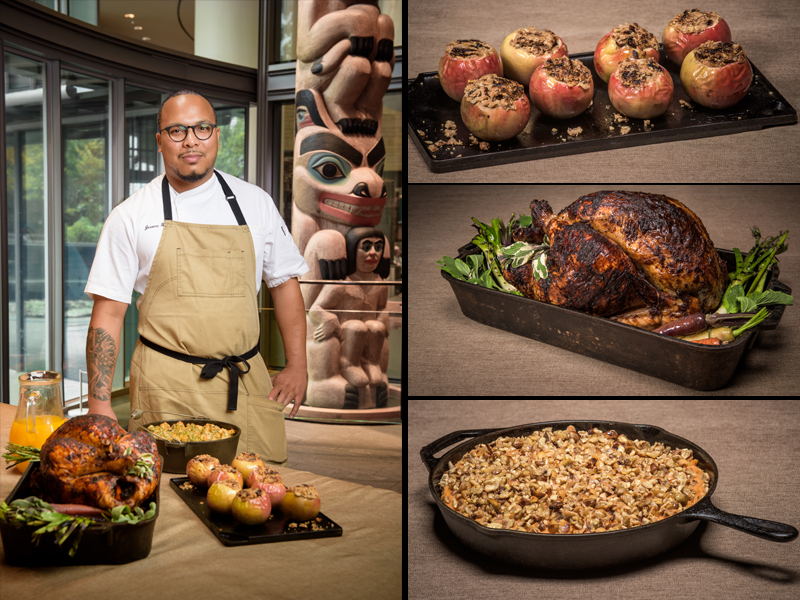

By Bonnie S. Benwick
When you look upon a bountiful table at this time of year, do you feel a connection to the squash, the fresh ginger, the apples, cornmeal, the sweet potatoes and walnuts? For natives of the Americas, the sense of relationship is strong, says Kevin Gover.
As director of the Smithsonian's National Museum of the American Indian in Washington and a member of the Midwestern Pawnee tribe, he's keenly aware of the bond: "There are ceremonies surrounding hunting, gathering, growing, harvesting and cooking food that have been around for thousands of years," he explains. "At gatherings, there is always at least one traditional dish among a menu that includes more contemporary dishes such as fry bread, which is something that has only been a part of the Native diet since resettlement."
A blend of the classic and contemporary is at the heart of the museum's food-centric mission. It's evident every day at its Mitsitam Native Foods Cafe, whose name is the equivalent of Italians' meal-bound "Mangia!," and it is reinforced by the festivals the museum has hosted annually for the past three years, designed to showcase storytelling, arts and other talents of individual American tribes.
Executive chef Jerome Grant oversees the festivals' culinary collaborations, when some of the tribes' best cooks are invited into the big cafe kitchens to demonstrate dishes for Mitsitam chefs. The recipes can be as simple as that fry bread: "Different tribes have their own ways of making it," the chef says. In Oklahoma, it's small and dense, while the Navajo nation in the Southwest makes it lighter, fluffier and the size of a paper plate. First, though, Grant and his sous-chefs do a lot of research. When the cooks come, "we pick their brains and find out whether we can source ingredients they're using," he says.
What comes out of the kitchen sessions almost always ends up on the menu at one of the cafe's many region-focused stations. For the wild elk stew from a tribesman in Oneida, N.Y., the meat is braised with dried cranberries, then cooked with garlic, corn mush and water.
Grant is on board for all of it - right down to serving deep-fried duck gizzards.
"The gizzards tasted like buttery nice chicken!" the chef says. "We sous-vided them, brined them in buttermilk, served them with a wild blueberry sauce. That's a good example of a traditional food with a modern twist." He welcomes Native American cooks into his kitchens about every two months.
"I love the fact that he's branching out beyond 'traditional' meats," says Leonda Levchuk, public affairs specialist at the Department of Health and Human Services' Indian Health Service program. "Visitors being able to try stuff like that is what gives the cafe part of its charm."
Grant, 33, isn't Native American, but he spent his early years on Indian reservations around Tulsa, as the son of a military father and bingo-aficionado mother. He ate food served at the local public schools and, after his dad was stationed at Andrews Air Force Base near the District, began his chef career as a short-order cook at a sports bar on the premises.
Grant graduated from culinary school in Pittsburgh and spent the early years of the 2000 decade cooking in St. Croix, where he learned much about Afro-Caribbean cuisine as well as the business side of chefdom.
After returning to Washington and working in restaurants for a few years, including at the Palomar hotel in Dupont Circle and at the now-closed IndeBleu downtown, Grant answered an ad for a sous-chef job at Mitsitam. "I love figuring out how to walk that fine line between traditional and contemporary," he says, "with an emphasis on indigenous and seasonal ingredients." He was made executive chef last year.
He takes full advantage of the Native American producers at his disposal, sourcing buffalo from 28 tribes in the Northwest; wild rice from the Red Lakes nation in Minnesota; dried chilies from Oaxaca, Mexico; corn and beans from the Southwest.
At Thanksgiving, his operation seems to really shine. The cafe is open on the holiday and does a fair amount of business, he says. More and more, people are ordering from the extensive take-home menu, which boasts soups, appetizers, salads, hot and cold side dishes, different types of meat, multiple dessert choices and beverages such as agua frescas, which Grant's team enjoys changing with the seasons.
They further challenged themselves to come up with an alternative to the maple-brined turkey they always offer for Thanksgiving.
Their pasilla-chili-rubbed turkey introduces rich, smoky flavor and a hint of sweetness into what can be a fairly bland centerpiece of the meal. The chef likes the roasted bird's rustic look and its color, which he finds reminiscent of the adobe clay homes of the Pueblo Indians in the Southwest.
"Each dish tells a story, through food, of who we as Americans are," Grant says. "When people sit down at the Thanksgiving table, they should think about the history behind it, and why they are celebrating it."
The Washington Post




